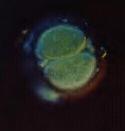 Day 1 Sperm joins with ovum (egg) to form one cell-smaller than a grain of salt. The new life has inherited 23 chromosomes from each parent, 46 in all. This one cell contains the complex genetic blueprint for every detail of human development - the child's sex, hair and eye color, height, and skin tone. During the next four weeks, the foundations of the brain, spinal cord and nervous system are established. At day 21, the heart begins to beat. By day 28, the backbone and muscles are forming and arms, legs, eyes and ears have begun to show.  Day 30 At one month old, the embryo is 10,000 times larger than the original fertilized egg, and developing rapidly. The placenta forms a unique barrier that keeps the mother's blood separate while allowing food and oxygen to pass through to the embryo. The heart is pumping increasing quantities of blood through the circulatory system. By day 35, five fingers can be discerned in the hand. The eyes darken as pigment is produced. At day 40, brain waves can be detected and recorded.  Week 7 The embryo begins to move spontaneously. The jaw forms, including teeth buds in the gums. Soon the eyelids will seal to protect the embryo's developing light-sensitive eyes, and will reopen at about the seventh month. At week 8, the embryo is a little more than an inch long and is now called a fetus, Latin for "young one" or "offspring." Everything is now present that will be found in a fully developed adult.  Week 10 The uterus has now doubled in size. Fingerprints are already evident in the skin. The fetus will curve his fingers around objects placed in its hand. The fetus can squint, swallow and wrinkle its forehead. At Week 11, the fetus is two inches long. Urination occurs. The fetus now sleeps, awakens and exercises its muscles energetically, turning his head, curling his toes, and opening and closing his mouth.  Week 14 Fine hair has begun to grow on the head, and sexual differentiation has become apparent. By the end of the fourth month, the fetus is eight to ten inches long and weighs half a pound or more. The mother will probably start to "show" now. The fetus can hear the mother's voice and heartbeat, as well as external noises. The umbilical cord has become an engineering marvel, transporting 300 quarts of fluids per day and completing a round trip of fluids every thirty seconds.  Month 5 Half the pregnancy has now passed, and the fetus is about 12 inches long. The mother feels movement, and if a sound is especially loud or startling, the fetus may jump in reaction to it. By the sixth month, oil and sweat glands are functioning. By the seventh month, the baby can see, hear, taste, touch and recognize his mother's voice. In the eighth month, the skin begins to thicken, with a layer of fat stored underneath for insulation and nourishment.  Month 9 Toward the end of this month, the baby is ready for birth. The average duration of pregnancy is 280 days from the first day of the mother's last menstrual period. By this time the infant normally weighs between six and nine pounds and his heart is pumping about 250 gallons of blood a day. The baby is fully capable of life outside the womb. |
Back to Scientific Issues
Back to Respect Life